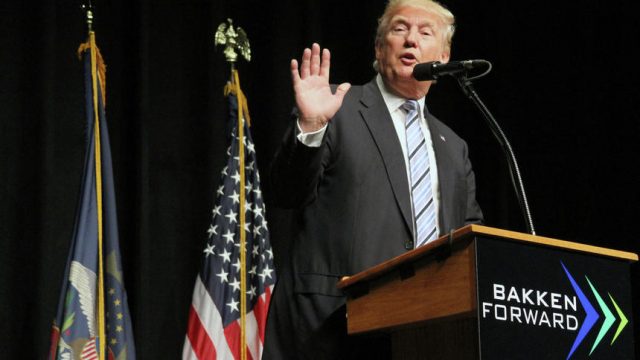Ed Schafer: Trump Should Emulate North Dakota on Tax Reform

It’s a great day in North Dakota and I welcome President Trump to the Bismarck and Mandan communities.
My hope is he learns about the ND experience and how the tax and regulation policies that have been instituted since the 1990s prepared a foundation for lower cost government, deficit spending elimination and increased business investment – policy that spurred our economy and put North Dakota on the national radar for economic improvement and personal income growth.
As we listen to all the political pundits, Washington DC elite and populist politicians bemoaning the commitment of President Trump to lower federal taxes and eliminate burdensome regulations, it is a good idea to review North Dakota’s rise to the top.
When our voters advanced Republican leadership in 1992, we inherited an economy that was in the tank, a government that couldn’t pay its bills and policy governance that insisted that raising taxes and putting in more controls were the answer to our doldrums. Hordes of people were leaving our state because they couldn’t find jobs to support themselves and their families.
I was elected with the promise to reduce the cost of government, reduce the cost of doing business and, importantly for the message today, lower taxes. And as President Trump pursues tax reduction and reform let us not forget the history of tax policy and its effect on deficit spending and business investment.
It was at the 1964 National Republican Convention in San Francisco when I heard President Reagan talk about tax burdens and how no nation in history has ever survived a tax burden that overtops a third of its national average income. He mentioned that our government was spending more than we were taking-in, and how we’d had to raise the debt limit three times in the last twelve months; how our debt burden was more than the combined debts of all the nations in the world, and how the purchasing power of the people was going down.
[mks_pullquote align=”left” width=”300″ size=”24″ bg_color=”#ffffff” txt_color=”#000000″]I was elected with the promise to reduce the cost of government, reduce the cost of doing business and, importantly for the message today, lower taxes. And as President Trump pursues tax reduction and reform let us not forget the history of tax policy and its effect on deficit spending and business investment.[/mks_pullquote]
Not much has changed has it?
That was typical of the economic situation we were faced with in ND. And the people were revolting against higher taxes and cut programs so we turned to President Reagan’s economic advisor, Art Laffer.
He helped us understand the “Laffer curve” and how raising taxes actually reduces government revenues. It is counterintuitive, but we crafted a budget for our state that lowered taxes that we hoped would lead to economic activity which would increase the revenues. Laffer’s theories proved true and our economic activity did bring in more revenues.
That plus reductions in the cost of our government allowed us to increase spending on education, health and safety programs for our citizens.
Reagan often talked about the conditions of business. In one presentation he said, “What does it mean whether you hold the deed or the title to your business or property if the government holds the power of life and death over that business or property?
The government can find some charge to bring against any concern it chooses to prosecute. Every businessman has his own tale of harassment. Somewhere a perversion has taken place. Our natural, inalienable rights are now considered to be a dispensation of government.”
I took his words to heart as we put together plans to enhance agriculture with value added enterprises, spur energy development and diversify our economy. We looked at the costs that government imposes on business—tax and regulation—and tried to come up with policies that would lower those costs.
We found ways to lower workers compensation premiums and drop unemployment insurance costs. One time in front of a combined session of the legislature, I put 80 pounds of business regulations on the podium and charged businesses to let us know which ones were in the way—barriers to investment in the state.
That is not to say that we were going to abandon good regulations—it should be pointed out in the arena of energy development today we are the best—but we also have the toughest regulations on well siting and hydraulic fracturing in the country! But we assured the business sector that we were going to apply the regulations fairly and consistently so they could calculate the long term costs of government and look for proper returns on their investments. We lowered the tax burden for our citizens and businesses.
And it worked! Businesses, instead of sending money into the government, spent the money on new machines, better buildings and, most importantly, on higher wages and new jobs.
Here is an example of how we created tax policy to help direct our economy. A lot of people I visit with about our economy say, “Sure, you have all the oil!” And it is true we have the largest oil play in the world in the last 40 years.
But this wasn’t just someone shouting “eureka” we found oil, for it was in 1995, more than 20 years ago, that we instituted a tax holiday on extraction taxes for horizontal well drilling. We saw drilling activity start to increase and went back to the legislature in 1997 to make the tax policy permanent. It has been a long steady climb of investment and productivity ever sense. Lower taxes was one of Ronald Reagan’s values that helped make our state what it is today.
Hopefully President Trump can champion the North Dakota experience as he faces opposition for his tax and regulation policy initiatives. We are here to prove he can make America great again!




